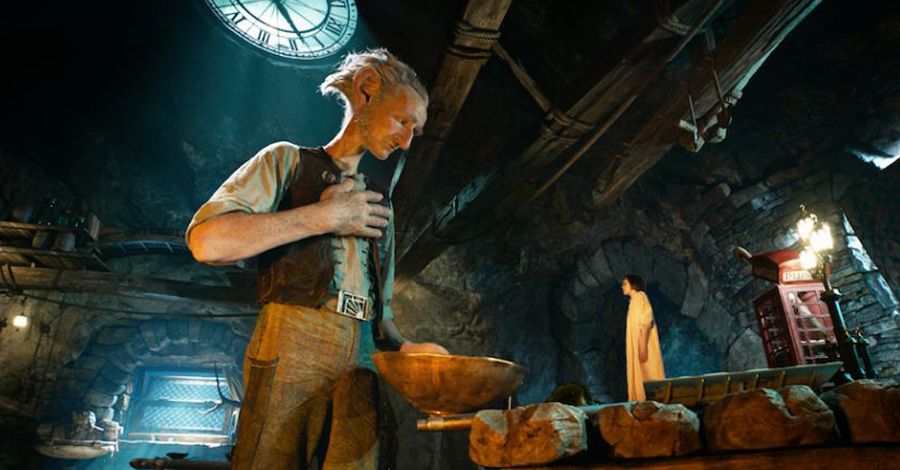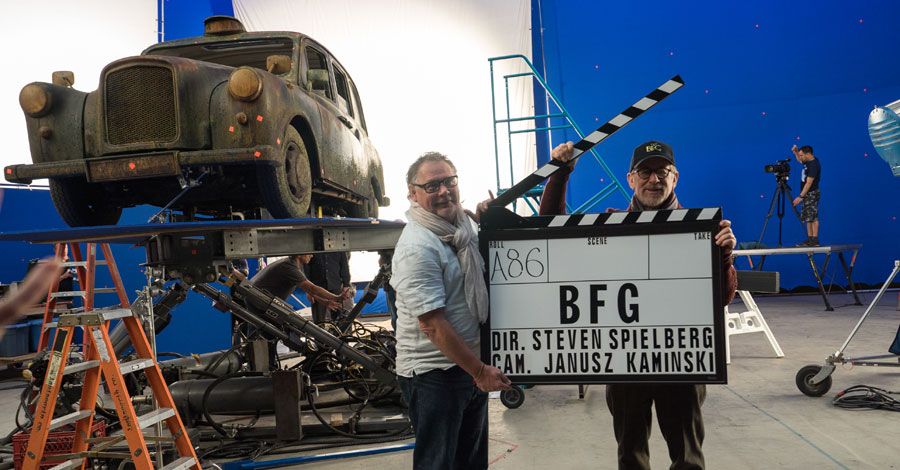“I’ll tell you one thing,” Steven Spielberg said of Disney’s “The BFG,” “we could not have made the movie the way you saw the film even five years ago.”
The director has worked on the cutting edge filmmaking effects throughout his career, from the shark of “Jaws” and the spacecraft of “Close Encounters of the Third Kind” to the titular alien of “E.T. the Extraterrestrial” and the prehistoric dinosaurs of “Jurassic Park.” And to convincingly craft the dark-tinged but whimsical world envisioned by author Roald Dahl in “The BFG,” Spielberg found himself once again testing the limits of visual effects technology.
“We wouldn’t have been able to get a virtual performance where you actually can feel the emotion from the character five years ago,” he said of the efforts to convey the nuanced melding of an actor’s performance – in this case Mark Rylance – within a computer-generated character, to a degree of reality not yet seen on screen. “Everybody says, ‘Oh, it’s the eyes, it’s the eyes.’ It’s not the eyes. It’s every single part of the emotional contours of bodily expression, of facial expression, of the vocalizations.”
“So capturing Mark and trying to preserve the magic that he gave Ruby [Barnhill] and us every day when they were actually performing their roles, transposing that on to an animated character could not have been possible in this way five years ago,” Spielberg added. “We would have only been able to really kind of capture 50 percent of what Mark was giving us, and now we have I think 95 percent of what Mark gave us.”
To hit that elevated goal post, Spielberg worked in concert with New Zealand-based Weta Digital, known for its boundary-expanding work on the “Lord of the Rings” and “Hobbit” trilogies, “Avatar,” the rebooted “Planet of the Apes” films and Spielberg’s own “Tintin,” with a team headed up by Oscar-winning senior visual effects artist Joe Letteri.
“We wanted the moment that Steven and Mark and Ruby were all getting to work together on stage to be the moments that translated into the film,” Letteri told Spinoff Online. “So [we were] taking this idea of motion capture away from being a science project, and making it more of a theatrical experience. We built sets, we created lighting for it, we tried to really give them a place to work out all the drama and all the moments.”
RELATED: Spielberg on "The BFG's" Magical Tale, and Crafting the Ultimate Fart Joke
“Once Steven turned those over to us, then we had the task of figuring out what makes each moment so unique, and how do you turn that into a completely digital character like BFG, but still feel the heart that you felt in Mark Rylance’s performance?” he continues. “So it was a lot of fun – it was very exhilarating, but it was also a lot of thought going into it.”
All the while, Letteri and his team remembered to keep Spielberg’s overall filmmaking philosophy – to give effective storytelling precedence over eye-popping spectacle – at the forefront of their efforts. “We got a chance to work with Steven before when we did ‘Tintin’ together, so the idea of building story first is something that was very familiar to us,” Letterri said. “And we worked with him at that level. It was always about what moment are we trying to achieve on screen, and how does that fit with the larger story? Both for the character development and the plot. And Steven was very collaborative that way. He’s really great about wanting people to come up with ideas and trying to figure out how we can always expand on what was there.”
The entirety of the film – even exterior sequences like the seemingly vast spaces of Giant Country – was shot inside a massive converted industrial facility in Vancouver. “It was like a 300,000 square feet of space, and we utilized every square foot of it!” Spielberg said. “All the exteriors were inside. We build every exterior inside. Dream Country was built inside; the orphanage was a full-size set, that was inside. Buckingham Palace, the interior of that is a huge sound stage that Rick Carter designed.”
“We had sets build all over the place,” he added. “We had a construction. We had a mill where the sets were built right on the sound stage. So I never really left in Vancouver. I never really got out of the space, except to go into Vancouver proper and go to bed, and then get up in the morning, go back to that space. I had three months of that.”
REVIEW: Disney's "The BFG" is a Big Miss For Spielberg
Even as a performer who took part in each of the scenes, Rylance found himself dazzled when he saw the finished effect. “When I first see a film, I’m amazed at how it works,” he said. “I remember the parts and in this film, because of the scale, we were on different sets for my parts and then for Ruby’s parts. The fact that it looked like we were having a conversation and it was all fluid, I was just kind of amazed by that.”
“Initially, I could see even Steven with all this experience, was quite overwhelmed the first few days by what he, as a director, had to keep in his mind,” Rylance added. “All the technical [information], all the different ways that images were being fed to him.”
“There was a nuance there to Mark’s performance that really required a whole other level of attention to detail,” Letteri said.
The effects guru also has to bring the various ethereal, multicolored and often spritely animated dreams and nightmares hunted by the BFG to vivid detail. “[Something] that for us was kind of magical was working out those dreams,” Letteri said. “How do they fit into the story? Obviously, they’re a key component of it, but they’re both lyrical, but also very realistic. So we spent a long time with Steven going through how much do you show? How much do you imply? How much do you tease what these dreams are all about? Because you need to leave room in the audience to have some imagination that they could bring to it themselves.”
“My favorite part is a scene called ‘Return to the Orphanage,’” said Weta VFX supervisor Guy Williams. “It’s in the middle of the movie when BFG takes Sophie back to the orphanage. And there’s this really beautiful performance that happens between Mark and Ruby where they basically confront each other and challenge each other, and then some hard decisions are made. The quality of performance that came out of that was exceptional from both actors, and having the visual effects live up to that potential and carry all that performance through to the screen, it just blew me away.”
Jemaine Clement, who plays the hulking, temperamental giant Fleshlumpeater, said he found that one of the keys to creating his own performance was simply looking past all of the technological tools in place to help him.
“It’s forgetting the technology,” Clement told Spinoff. “So that’s kind of the challenge: forgetting that it’s going to be a CGI body. When you first see yourself as CGI and you see that you’re controlling it, it’s really tempting to walk like a bad CGI character from a video game. So you have to ignore that and become very analog in what you do, and very natural and organic.”
Rylance says Spielberg has achieved a milestone that will ultimately set the standard for motion capture performance. “I think in future, if this becomes a technique that many actors get involved with, it’s gonna become contractual eventually that you have someone put as much time as Steven did into making sure that my face came through,” he said.
Disney’s “The BFG” opens Friday nationwide.



